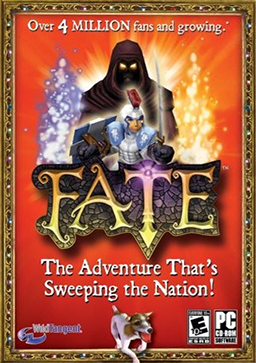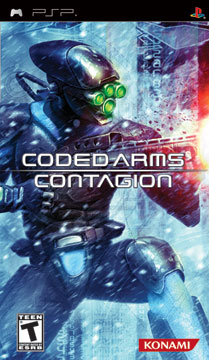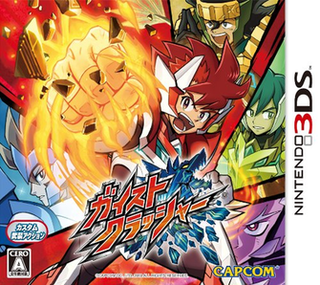
System Shock is a 1994 first-person action-adventure video game developed by LookingGlass Technologies and published by Origin Systems. It was directed by Doug Church with Warren Spector serving as producer. The game is set aboard a space station in a cyberpunk vision of the year 2072. Assuming the role of a nameless security hacker, the player attempts to hinder the plans of a malevolent artificial intelligence called SHODAN.
Steel Beasts is the name for a family of tank simulators created by eSim Games for Microsoft Windows.

Unreal II: The Awakening is a first-person shooter video game developed by Legend Entertainment and published by Infogrames under the Atari brand for Microsoft Windows, the game was later ported to Microsoft's Xbox console by Tantalus. It is the sequel to the 1998 video game Unreal and part of the franchise of the same name. Cliff Bleszinski was an executive producer for the title.

Tyrian is a vertically scrolling shooter developed by Eclipse Software for MS-DOS and published in 1995 by Epic MegaGames. Tyrian was programmed by Jason Emery, illustrated by Daniel Cook, and its music composed by Alexander Brandon and Andras Molnar. The game was re-released as freeware in 2004. A free and open-source port of the game started in April 2007.

Jagged Alliance 2 is a tactical role-playing game released in 1999 for Microsoft Windows and later ported to Linux by Tribsoft. It is the third entry in the Jagged Alliance series. The game was followed by the expansion Unfinished Business in 2000. Two commercial versions of the mod Wildfire were released in 2004 in the form of expansion packs. The core game and the Unfinished Business expansion were combined and released under the title Jagged Alliance 2 Gold Pack in 2002.

Jagged Alliance is a tactical role-playing game released in 1995 for MS-DOS. It was developed by Madlab Software and published by Sir-Tech. It is the first game in the Jagged Alliance series. It was re-released in 2008 on GOG.com and in 2010 on GamersGate, both with Windows support. A version for Nintendo DS was released in 2009

Samurai Warriors is the first title in the series of hack and slash video games created by Koei's Omega Force team based closely around the Sengoku period of Japanese history and it is a sister series of the Dynasty Warriors series, released for the PlayStation 2 and Xbox in 2004. A port of this game called Samurai Warriors: State of War has been released for the PlayStation Portable, which includes additional multiplayer features.

Knights of the Round is an arcade game released by Capcom in 1991. A side-scrolling beat 'em up based loosely on the legend of King Arthur and the Knights of the Round Table, the game features an action role-playing video game-like level advancement system, with fighters automatically being upgraded to new weapons and armor as they advance through the game. In September 13, 2018, Capcom announced Capcom Beat 'Em Up Bundle with the arcade edition of Knights of the Round being one of seven titles and being released digitally for Nintendo Switch, PlayStation 4, Xbox One, and Windows on September 18, 2018.

Killzone: Liberation is a third-person shooter video game developed by Guerrilla Games and published by Sony Computer Entertainment for the PlayStation Portable (PSP). It was originally released on 31 October 2006 in North America. It is a follow-up to Killzone, taking place two months after the original game. Killzone: Liberation is the only PSP installment in the series, and the first of only two for Sony's handheld consoles, the second of which was Killzone: Mercenary for the PlayStation Vita in 2013. An updated version of Liberation was released on 20 June 2023 for the PlayStation 4 and PlayStation 5.

Fate is a 2005 single-player action role-playing game originally released for the PC by WildTangent. Fate was released for the PC Steam client on December 12, 2013. Three sequels—titled Fate: Undiscovered Realms, Fate: The Traitor Soul and Fate: The Cursed King—were released in 2008, 2009 and 2011 respectively.

Battlefield 2142 is a 2006 first-person shooter video game developed by DICE and published by Electronic Arts. It is the fourth game in the Battlefield series. Battlefield 2142 is set in 2142, depicting a war known as "The Cold War of the 22nd Century", in which two military superpowers – the European Union (EU) and Pan Asian Coalition (PAC) – battle for the remaining unfrozen land during a new ice age.

Dynasty Warriors is a game in the Dynasty Warriors series for the PlayStation Portable, created by the game development company Koei. This game was released as a launch title in Japan on December 16, 2004 and as a launch title on March 17, 2005 in North America, and September 1, 2005 in Europe. The sequel to this game is Dynasty Warriors Vol. 2.

Coded Arms: Contagion is a first-person shooter video game developed by Russian studio Creat Studios. It is the sequel to Coded Arms.

Alien Syndrome is a video game by Totally Games, part of the Alien Syndrome franchise created by Sega. It was released for the PlayStation Portable and Wii in 2007. This iteration takes place a century after the previous game and introduces role-playing elements to the gameplay.
Little Fighter 2 is a Hong Kong freeware PC fighting game for Windows and is the sequel to the game Little Fighter. Little Fighter 2 was created by Marti Wong and Starsky Wong in 1999, and received a long series of updates.

Metal Gear Solid: Peace Walker is a 2010 stealth game developed by Kojima Productions and published by Konami. It is the seventh Metal Gear game written, directed, and designed by Hideo Kojima, and the fifth installment of the Metal Gear Solid series, as well as the fourth Metal Gear game made specifically for the PlayStation Portable, following Metal Gear Solid: Portable Ops. A remastered version of the game titled Metal Gear Solid: Peace Walker - HD Edition was later released for the PlayStation 3 and Xbox 360 as part of the Metal Gear Solid HD Collection in North America and Europe and as a stand-alone retail release in Japan.

F-16 Combat Pilot is a 1989 F-16 fighter flight simulator created by British software company Digital Integration Ltd. for Amiga, Atari ST, DOS, Commodore 64, Amstrad CPC and ZX Spectrum. It is considered as one of the first combat flight simulators to have a dynamic campaign environment. While the graphics, scenery and audio are quite sparse and basic, the instruments and flight dynamics of a F-16C Fighting Falcon are fully featured and modeled.

God of War: Ghost of Sparta is an action-adventure hack and slash video game developed by Ready at Dawn and published by Sony Computer Entertainment (SCE). It was first released for the PlayStation Portable (PSP) handheld console on November 2, 2010. The game is the sixth installment in the God of War series and the fourth chronologically. Loosely based on Greek mythology, Ghost of Sparta is set in ancient Greece with vengeance as its central motif. The player controls the protagonist Kratos, the God of War. Kratos is still haunted by the visions of his mortal past and decides to explore his origins. In Atlantis, he finds his mother Callisto, who claims that his brother Deimos is still alive. Kratos journeys to the Domain of Death to rescue his brother. After initial resentment from Deimos, the brothers team up to battle the God of Death, Thanatos, Deimos' captor.

Gaist Crusher is an action video game developed by Treasure and published by Capcom. It was released for the Nintendo 3DS on December 5, 2013 in Japan. The game launched as a part of a cross-media franchise including manga adaptations in Shueisha magazines and an anime television adaptation by Pierrot.
This is a non-comprehensive list that includes terms used in video games and the video game industry, as well as slang used by players.

















